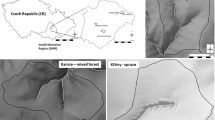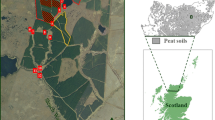Abstract
The aim of this study was to evaluate effects of forestry practices on water resources in the middle-boreal zone of central Finland. The long-term research was performed at Kivesvaara experimental plots (64∘28′ N, 27∘33′ E) and Oijusluoma small catchments (65∘50′ N, 29∘0′ E), with a detailed snow observation at Paljakka (65∘26′ N, 26∘26′ E). Forestry practices included clear-cut, shelterwood and seed cutting with different techniques of soil preparation and reforestation. The clear-cut (particularly by the total biomass harvest including stump removal) has increased the water yield (a positive feedback). But, on the other hand, it has caused a drop in retention and lag-time, and an increase of peak-flows, as well as increasing mobility of nitrogen and phosphorus. Thus, the clear-cut of mature spruce stands (Picea abies) increased the groundwater recharge by 63 mm (i.e., 24%), and the total biomass harvest of one-half of the experimental catchment increased the water yield by 44 mm (i.e., 15%) during three years after the harvest. A significant increase in contents of nitrogen persisted in groundwaters more than 25 years after the clear-cut, and 10 years after the natural regeneration (shelterwood or seed cutting). During the monitored period of 28 years, the total output of nitrogen from subsequent forest plantations ranged from 12 to 21 tons per hectare (i.e., exceeding 5–9 times the output from control mature spruce stands). By natural regeneration, the ten-year mean load of nitrogen exceeded 2.5–5 times the load at control plots. After the total biomass harvest (a whole tree and stump removal), the mean annual outflow of nitrogen and phosphorus was 5.4 and 0.11 k g h a −1 (exceeding 2.5 and 1.8 times the pre-treatment stream-flow). These results confirmed the hypothesis of a significant impact of forest practices on water resource control in the boreal forest biome.








Similar content being viewed by others
References
Ahtiainen M, Huttunen P (1999) Long-term effects of forestry managements on water quality and loading in brooks. Boreal Environ Res 4:101–114
Bergström S (1992) The HBV model – its structure and applications. SMH1 Reports Hydrology No. 4, Swedish Meteorological and Hydrological Institute, Norrköping, Sweden, p 35
Bosch JM, Hewlett JD (1982) A review of catchment experiments to determine the effect of vegetation changes on water yield and evapotranspiration. J Hydrol 55:3–23
Chuankuan W, Xiaofeng Z (1994) Studies on forest benefits on decreasing flood discharge and increasing base runoff in northern China. In: Proceedings of the international symposium on forest hydrology. University of Tokyo, Tokyo, pp 545–549
EC (2012) Report on the implementation of the Water Framework Directive: Finland. Commission Staff Working Document, COM 670, European Commission, Brussel, p 63
Foster NW, Bhatti JS (2006) Forest ecosystems: nutrient cycling. In: Encyclopedia of Soil Science. Taylor & Francis, New York, USA, pp 718–721
Grip H (1982) Water chemistry and runoff in forest streams at Kloten. Dissertation, UNGI rapport 58, Uppsala University, Uppsala, Sweden, p 144
Hämet-Ahti L (1981) The boreal zone and its biotic subdivisions. Fennia-Int J Geogr 159:69–75
Hawkins RH, Ward TJ, Woodward DE, Van Mullem JA (2009) Curve number hydrology: state of the practice. American Society of Civil Engineers, Reston, Virginia, p 112
Kilpeläinen T, Tuomenvirta H, Jylhä K (2008) Climatological characteristics of summer precipitation in Helsinki during the period 1951–2000. Boreal Environ Res 13:67–80
Kortelainen P, Mattsson T, Finér L, Ahtiainen M, Saukkonen S, Sallantaus T (2006) Controls on the export of C, N, P and Fe from undisturbed boreal catchments, Finland. Aquat Sci 68:453–468
Kremsa J (2016) Effects of forest harvesting on runoff processes in the boreal environment. In: Czech. Dissertation, Czech Technical University in Prague, Prague, Czech Republic, p 122
Kremsa J, Křeček J, Kubin E (2015) Comparing the impacts of mature spruce forests and grasslands on snow melt, water resource recharge, and run-off in the northern boreal environment. Int. J. Soil Water Conserv Res 3:50–56
Krčmář V, Křeček J, Vrtiška J (2014) Effects of forest harvest on the vegetation cover: Oijusluoma, Finland. Special Technical Map, Faculty of Civil Engineering Czech Technical University in Prague, Prague, Czech Republic
Kubin E (1995a) Site preparation and leaching of nutrients. In: Ritari A, Saarenmaa H, Saarela M, Poikajärvi (eds) Proceedings of the IUFRO symposium, Northern silviculture and management. August 16–22, 1987, Lapland, Finland. Metla research notes, vol 567, pp 55–62
Kubin E (1995b) The effect of clear cutting, waste wood collecting and site preparation on the nutrient leaching to groundwater. In: Nilsson LO, Hüttl RF, Johansson UT (eds) Nutrient uptake and cycling in forest ecosytems. Kluwer, Dordrecht, pp 661–670
Kubin E (1998) Leaching of nitrate nitrogen into the groundwater after clear felling and site preparation. Boreal Environ Res 3:3–8
Kubin E, Kemppainen L (1991) Effect of clear cutting of boreal spruce forest on air and soil temperature conditions. Acta Forestalia Fennica 225:1–42
Kubin E, Krecek J (2008) Impact of forestry practices on groundwater quality in the boreal environment. In: Taniguchi M, Burnett WC, Fukushima Y, Haigh M, Umezawa Y (eds) From headwaters to the ocean: hydrological change and water management. CRC press, Kyoto, Japan, pp 91–96
Lupi C, Morin H, Deslauriers A, Rossi S, Houle D (2013) Role of soil nitrogen for the conifers of the boreal forest: a critical review. Int J Plant Soil Sci 2:155–189
MEA (2005) Ecosystems and human well-being: synthesis. Millenium Ecosystem Assessment, Island Press, Washington, D.C., USA, p 155
Metla (2014) Finnish statistical yearbook of forestry (in finnish): Official statistics of Finland: Agriculture, forestry and fishery, 44 ed. The Finnish Forest Research Institute (Metla), Helsinki, Finland, p 450
NASA (2014) Landsat science. http://landsat.usgs.gov. Accessed on the 24th october 2016
Nash JE, Sutcliffe JV (1970) River flow forecasting through conceptual models part i – a discussion of principles. J Hydrol 10:282–290
Poikolainen J, Piispanen J, Karhu J, Kubin E (2009) Long-term changes in nitrogen deposition in Finland (1990–2006) monitored using the moss Hylocomium splendens. Environ Pollut 157:3091–3097
Rekolainen S, Posch M, Kämäri J, Ekholm P (1991) Evaluation of the accuracy and precision of annual phosphorus load estimates from two agricultural basins in Finland. J Hydrol 128:237–255
Rusanen K, Finer L, Antikainen M, Korkka-Niemi K, Backman B, Britschgi R (2004) The effect of forest cutting on the quality of groundwater in large aquifers in Finland. Boreal Environ Res 9:253–261
Saastamoinen O, Matero J, Horne P, Kniivilä E, Haltia E, Vaara M, Mannerkoski H (2014) Classification of boreal forest ecosystem goods and services in Finland. Reports and Studies in Forestry and Natural Sciences, No. 11, University of Eastern Finland, Finland, p 197
Seibert J (2005) HBV Light version 2, user’s manual. Stockholm University, Stockholm, Sweden, p 16
Shaw EM (1991) Hydrology in Practice. Chapman & Hall, London, United Kingdom, p 537
Sullivan C (2002) Calculating a water poverty index. World Dev 30:1195–1210
Tamm CO, Holmen H, Popovic B, Wiklander G (1974) Leaching of plant nutrients from soils as a consequence of forestry operations. Ambio 3:211–221
Vuorenmaa J, Rekolainen S, Lepisto A, Kenttamies K, Kauppila P (2002) Losses of nitrogen and phosphorus from agricultural and forest areas in Finland during the 1980s and 1990s. Environ Monit Assess 76:213–248
Weier J, Herring D (2000) Measuring vegetation (NDVI & EVI). Earth observatory, http://earthobservatory.nasa.gov. Accessed on the 24th october 2016
Zhang L, Dawes WR, Walker GR (2001) Response of mean annual evapotranspiration to vegetation changes at catchment scale. Water Resour Res 37:701–708
Acknowledgements
The study was supported by the Finnish Ministry of Agriculture and Forestry (Programme on Groundwater and catchment impacts of stump harvesting), Czech Technical University in Prague (SGS 14/128/OHK1/2T/11) and the Ministry of Education of the Czech Republic (INTER-EXCELLENCE: INTER-COST LTC 17006, 2017). The experimental treatment was managed by UPM and Metsähallitus, field observations and chemical analyses carried out by Luke (Natural Resources Institute Finland). The Oulanka Research Station of the Oulu University supported water sampling and run-off registrations.
Author information
Authors and Affiliations
Corresponding author
Rights and permissions
About this article
Cite this article
Kubin, E., Křeček, J. & Palán, L. Effects of Forest Practices on Water Resources Recharge in the Boreal Climate. Environ. Process. 4, 509–522 (2017). https://doi.org/10.1007/s40710-017-0249-4
Received:
Accepted:
Published:
Issue Date:
DOI: https://doi.org/10.1007/s40710-017-0249-4




